Related Research Articles

Lowndes County is in the central part of the U.S. state of Alabama. As of the 2020 census, the county's population was 10,311. Its county seat is Hayneville. The county is named in honor of William Lowndes, a member of the United States Congress from South Carolina.
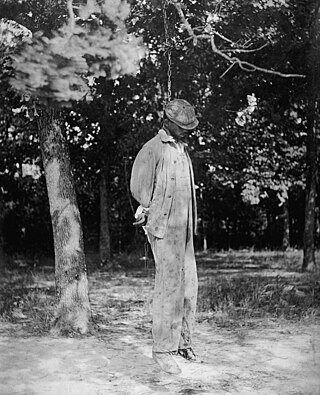
Lynching is an extrajudicial killing by a group. It is most often used to characterize informal public executions by a mob in order to punish an alleged transgressor, punish a convicted transgressor, or intimidate people. It can also be an extreme form of informal group social control, and it is often conducted with the display of a public spectacle for maximum intimidation. Instances of lynchings and similar mob violence can be found in every society.
Extrajudicial punishment is a punishment for an alleged crime or offense which is carried out without legal process or supervision by a court or tribunal through a legal proceeding.

Ida Bell Wells-Barnett was an American investigative journalist, educator, and early leader in the civil rights movement. She was one of the founders of the National Association for the Advancement of Colored People (NAACP). Wells dedicated her career to combating prejudice and violence, and advocating for African-American equality—especially that of women.
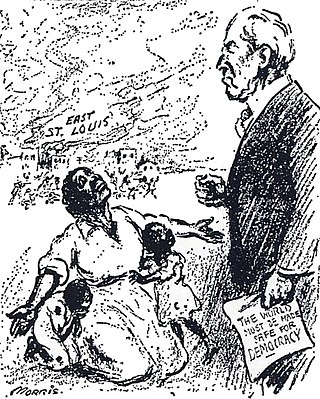
The East St. Louis massacre was a series of violent attacks on African Americans by white Americans in East St. Louis, Illinois between late May and early July of 1917. These attacks also displaced 6,000 African Americans and led to the destruction of approximately $400,000 worth of property. They occurred in East St. Louis, an industrial city on the east bank of the Mississippi River, directly opposite the city of St. Louis, Missouri. The July 1917 episode in particular was marked by white-led violence throughout the city. The multi-day rioting has been described as the "worst case of labor-related violence in 20th-century American history", and among the worst racial riots in U.S. history.

Femicide or feminicide is a term for the hate crime of systematically killing women, girls, or females in general because of their sex. In 1976, the feminist author Diana E. H. Russell first implicitly defined the term as a hate killing of females by males but then went on to redefine it as "the killing of females by males because they are female" in later years. Femicide can be perpetrated by either gender but is more often committed by men. This is most likely due to unequal power between men and women as well as harmful gender roles, stereotypes, or social norms.

The Dyer Anti-Lynching Bill (1918) was first introduced in the 65th United States Congress by Representative Leonidas C. Dyer, a Republican from St. Louis, Missouri, in the United States House of Representatives as H.R. 11279 in order “to protect citizens of the United States against lynching in default of protection by the States.” It was intended to establish lynching as a federal crime. The Dyer Anti-Lynching Bill was re-introduced in subsequent sessions of United States Congress and passed, 230 to 119, by the House of Representatives on January 26, 1922, but its passage was halted in the United States Senate by a filibuster by Southern Democrats, who formed a powerful block. Southern Democrats justified their opposition to the bill by arguing that lynchings were a response to rapes and proclaiming that lynchings were an issue that should be left for states to deal with.
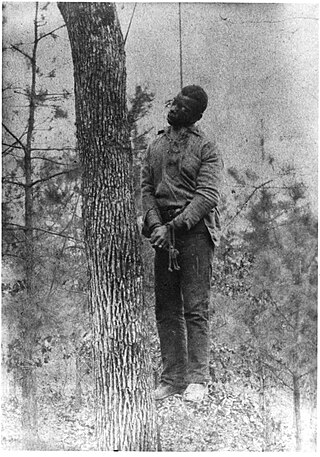
Lynching was the widespread occurrence of extrajudicial killings which began in the United States' pre–Civil War South in the 1830s and ended during the civil rights movement in the 1950s and 1960s. Although the victims of lynchings were members of various ethnicities, after roughly 4 million enslaved African Americans were emancipated, they became the primary targets of white Southerners. Lynchings in the U.S. reached their height from the 1890s to the 1920s, and they primarily victimised ethnic minorities. Most of the lynchings occurred in the American South, as the majority of African Americans lived there, but racially motivated lynchings also occurred in the Midwest and border states. In 1891, the largest single mass lynching in American history was perpetrated in New Orleans against Italian immigrants.
Missing white woman syndrome is a term used by social scientists and media commentators to denote disproportionate media coverage, especially on television, of missing-person cases toward white females compared to those females of colour or males. The syndrome also encompasses disproportionate media attention to females who are young, attractive, white, and upper middle class. Although the term was coined in the context of missing-person cases, it is sometimes used of coverage of other violent crimes. The phenomenon has been highlighted in the United States, Canada, the United Kingdom, Australia, New Zealand, and other predominantly white countries, as well as South Africa.

An extrajudicial killing is the deliberate killing of a person without the lawful authority granted by a judicial proceeding. It typically refers to government authorities, whether lawfully or unlawfully, targeting specific people for death, which in authoritarian regimes often involves political, trade union, dissident, religious and social figures. The term is typically used in situations that imply the human rights of the victims have been violated; deaths caused by legal police actions or legal warfighting on a battlefield are generally not included, even though military and police forces are often used for killings seen by critics as illegitimate. The label "extrajudicial killing" has also been applied to organized, lethal enforcement of extralegal social norms by non-government actors, including lynchings and honor killings.
A false accusation of rape happens when a person states that they or another person have been raped when no rape has occurred.
African Americans, and African American males in particular, have an ethnic stereotype in which they are portrayed as dangerous criminals. This stereotype is associated with the fact that African Americans are proportionally over-represented in the numbers of those that are arrested and convicted for committing crimes. It has appeared frequently in American popular culture, reinforcing the negative consequences of systemic racism.
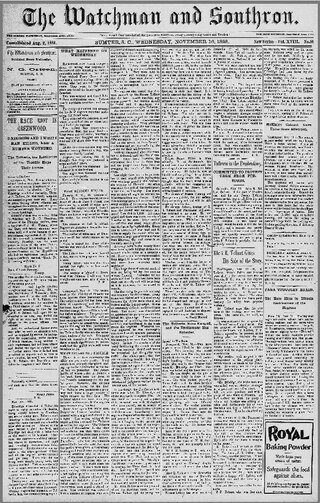
The Phoenix election riot occurred on November 8, 1898, near Greenwood County, South Carolina, when a group of local white Democrats attempted to stop a Republican election official from taking the affidavits of African Americans who had been denied the ability to vote. The race-based riot was part of numerous efforts by white conservative Democrats to suppress voting by blacks, as they had largely supported the Republican Party since the Reconstruction era. Beginning with Mississippi in 1890, and South Carolina in 1895, southern states were passing new constitutions and laws designed to disenfranchise blacks by making voter registration and voting more difficult.
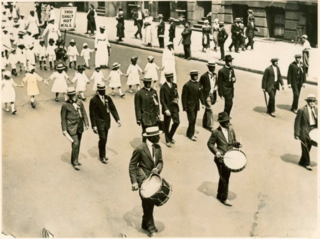
The anti-lynching movement was an organized political movement in the United States that aimed to eradicate the practice of lynching. Lynching was used as a tool to repress African Americans. The anti-lynching movement reached its height between the 1890s and 1930s. The first recorded lynching in the United States was in 1835 in St. Louis, when an accused killer of a deputy sheriff was captured while being taken to jail. The black man named Macintosh was chained to a tree and burned to death. The movement was composed mainly of African Americans who tried to persuade politicians to put an end to the practice, but after the failure of this strategy, they pushed for anti-lynching legislation. African-American women helped in the formation of the movement, and a large part of the movement was composed of women's organizations.
Eliza Woods was an African-American woman who was lynched on 19 August 1886 in Jackson, Tennessee, after being accused of poisoning and killing her employer, Jessie Woolen.
The relationship between race and capital punishment in the United States has been studied extensively. As of 2014, 42 percent of those on death row in the United States were Black. As of October 2002, there were 12 executions of White defendants where the murder victim was Black, however, there were 178 executed defendants who were Black with a White murder victim. Since then, the number of white defendants executed where the murder victim was black has increased to just 21, whereas the number of Black defendants executed where the murder victim was White has increased to 299. 54 percent of people wrongfully convicted and sentenced to death in the United States are black.
The feminist pathways perspective is a feminist perspective of criminology which suggests victimization throughout the life course is a key risk factor for women's entry into offending.
In the early hours of 3 June 1893, a black day-laborer named Samuel J. Bush was forcibly taken from the Macon County, Illinois, jail and lynched. Mr. Bush stood accused of raping Minnie Cameron Vest, a white woman, who lived in the nearby town of Mount Zion.
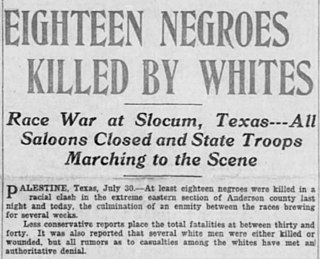
The Slocum Massacre occurred on July 29–30, 1910, in Slocum, Texas, an unincorporated community in Anderson County near Palestine in East Texas. Only six deaths were officially confirmed, but some 22 were reported by major newspapers. This is the official count, and it is estimated as many as one hundred African Americans were killed.
References
- ↑ "Considering History: The Role of Women in the Lynching Epidemic". The Saturday Evening Post. 13 March 2019. Retrieved 2023-12-06.
- ↑ "'Of These, One was a Woman': The Lynching of African American Women, 1885-1946". Cornell University . Retrieved 2023-12-05.
- ↑ "LYNCHING BEYOND DIXIE: AMERICAN MOB VIOLENCE OUTSIDE THE SOUTH". Rutgers. January 2014. Retrieved 2023-12-06.
- ↑ Baker, David V.; Garcia, Gilbert (2019). "An Analytical History of Black Female Lynchings In The United States, 1838-1969". Journal of Qualitative Criminal Justice & Criminology. Qualitative Criminology. doi: 10.21428/88de04a1.105517eb . Retrieved 2023-12-06.
- ↑ Feimster, Crystal N. (28 April 2018). "Ida B. Wells and the Lynching of Black Women". The New York Times . Retrieved 2024-01-13.